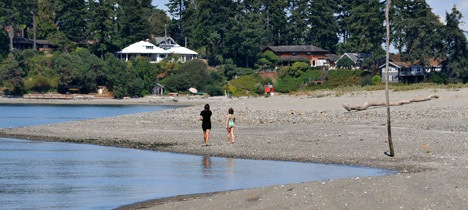A government study says that Bill Point’s East Beach and north shoal, at one time part of Bainbridge Island’s Wyckoff Superfund site, are unsafe for use by children and pets.
According to the Agency for Toxic Substances and Disease Registry (ATSDR), recent testing in the area uncovered potentially harmful levels of toxic chemicals that pose a health risk to island residents and animals that frequent the specific area. The chemicals detected included polycyclic aromatic hydrocarbons (PAH), which have been linked to cancer.
The report concluded that children and animals should avoid the north and east beaches because they are more susceptible to harm from the contaminants. It also warned against eating bottom fish living in the harbor due to elevated levels of mercury and polychorinated biphenyls (PCBs). The ATSDR conducted the study at the request of the Environmental Protection Agency (EPA) to ensure that park-goers and residents were not at risk.
Because contamination exists, there are precautions people should take to keep themselves safe. The EPA recommends keeping children and pets off the beach; washing your hands if you have come in contact with the sand; not digging on the beach or mudflats; and not eating bottom fish from the harbor.
ATSDR has advised the EPA to increase the number of signs warning residents about the contaminants because most of the contamination is contained and the rest is exposed only at low tide. The ATSDR and EPA say there is little they can do to stop the chemicals from leaching at this time.
“People should avoid the beach at low-tide,” said Howard Orlean, a Superfund project manager for EPA.
According to the ATSDR report swimming, boating and fishing in Eagle Harbor are safe for people, as are the beaches and upland areas of Pritchard Park, said the report.
Hydrocarbons and other toxic chemicals such as PCBs, were byproducts of the Wyckoff Co. wood treatment plant, which, beginning in the early 1900s, operated at Bill Point for several decades. The EPA designated the area a Superfund site in 1987, which resulted in a steel pile-wall placed to prevent the contamination from spreading. But, the ATSDR report said, PAHs continue to seep up from the mud and sediment along the beach.
Orlean said the chemicals contaminating the beach are not coming from inside the pile wall. The wall is made up of large metal piles that were driven into the ground and welded together, forming a barrier between the harbor and most of the contamination.
“There is still some residual contamination outside the wall,” Orlean said. “Because of the site’s proximity to the water, the EPA was not able to construct the wall around all of the affected area.”
Outside the wall, the amount of chemicals seeping up through the ground is small, Orlean said, but he warns anyone walking along the beach to keep off of the seeping areas, which have the appearance of small oil slicks, and are the most concentrated areas of contamination. Orlean said the seeps do not pose an immediate risk once they are in Puget Sound. He said the chemicals spread quickly and won’t affect people swimming or boating in the Eagle Harbor.
The EPA is taking precautions to ensure the contamination is not spreading, Orlean said. Besides the wall, officials have taken steps to help protect groundwater. There is a pumping station on site that draws up the contaminated water under the site and removes the harmful contaminants. The clean water is then released into the Sound.
Cleaning the groundwater helps remove some of the contamination, but most of it remains hidden under the site. Orleans said the EPA is satisfied that people are not being exposed to the dangerous chemicals. Therefore they do not plan to take any immediate action.
The City of Bainbridge Island is taking much the same stance. Libby Hudson, the long-range planning manager for the city, said any clean-up activities are up to the EPA.
“When the island and the park district bought the Wyckoff site (as part of Pritchard Park), they purchased liability coverage,” Hudson said. This means the city is not required to clean up the site, Hudson said, but the two agencies will be working with the EPA on all future remedies.



